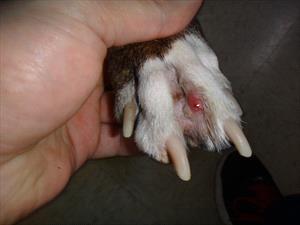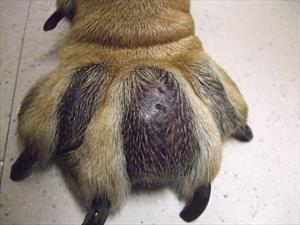What are Interdigital Cysts in Dogs?
Interdigital Furunculosis/Cysts, Dog (Photograph)

This dog has a cyst between his second and third toes. Photo by Dr. Matthew Galati
Interdigital cysts are large bumps, or nodules, between a dog’s toes. They can also be called interdigital furuncles, follicular pododermatitis, or podofurunculosis. Interdigital cysts usually appear as red nodules filled with blood and/or pus. They are most commonly found on the front paws. Dogs may limp from the pain, especially when walking on uneven surfaces or lick or chew at their paws.
What Causes Interdigital Cysts?
Any irritation or injury to the hairy skin of the paws can cause “plugged,” or dilated, hair follicles. These dilated follicles then develop into nodules that are prone to rupture, thus causing more irritation, and skin infections as well.
When a dog develops interdigital cysts, it’s important to work with your veterinarian to determine why they’re occurring. Multiple factors may be involved, including:
Hair coat
Dogs with short and coarse hair coats may be more likely to have inflamed and ruptured follicles. Breeds with this type of hair coat include English bulldogs, Great Danes, Basset hounds, mastiffs, bull terriers, and boxers.
Paw shape
Dogs with wider paws can be more likely to bear weight on the haired skin between the pads. Breeds with this type of paw shape, or conformation, include Labrador retrievers, English bulldogs, German shepherds, and Pekingese.
Obesity
Dogs that are overweight can put more pressure interdigitally, or on the spaces between toes when walking.
Difficulty walking
Dogs that have arthritis or other joint problems can put more pressure on the interdigital spaces when walking.
Licking and other itchy behavior
Dogs that lick or chew at their paws can cause hair and skin irritation that leads to interdigital cysts. In these dogs, diagnosing and managing the underlying cause of itching, such as allergies, is part of treating and preventing interdigital cysts.
Environment
Skin trauma from cages or rough ground can damage hair follicles.
Canine paw with interdigital cysts and pododermatitis

Dog's paw with interdigital cysts and pododermatitis (pillow foot). Photo courtesy of Dr. Iz Jakubowski
How are they Diagnosed?
Your dog’s veterinarian may need to take skin samples to diagnose and treat them because many other skin conditions can cause nodules on a dog’s paws. These skin conditions include demodicosis or demodectic mange from Demodex mites, skin cancers, and fungal infections.
How are Interdigital Cysts Treated?
Many become infected and need antibiotics. Your veterinarian may take a sample for a skin culture (bacterial culture and sensitivity) to choose the antibiotic. Anti-bacterial shampoos can also help treat the skin infection. If the paw swelling is severe, an anti-inflammatory medication to reduce the swelling and pain may be prescribed. Your veterinarian may also recommend surgical procedures or protective footwear.
Your veterinarian will also work with you to determine what’s causing the interdigital cysts. If the underlying causes aren’t diagnosed and treated, they could return and cause scarring and difficulty walking. Diagnosing why your dog is developing them can reduce the need for medications, such as antibiotics, and make your pet more comfortable.